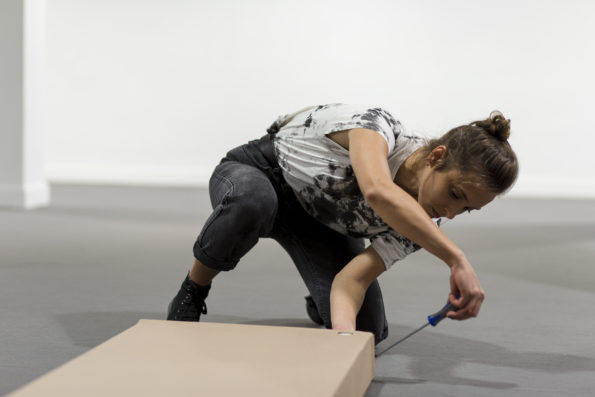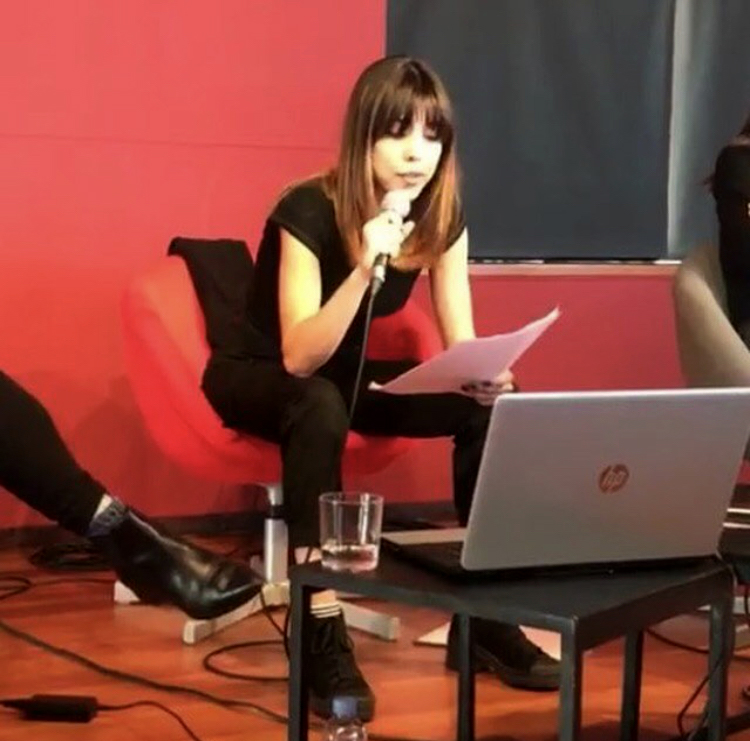Search
To search for an exact match, type the word or phrase you want in quotation marks.
A*DESK has been offering since 2002 contents about criticism and contemporary art. A*DESK has become consolidated thanks to all those who have believed in the project, all those who have followed us, debating, participating and collaborating. Many people have collaborated with A*DESK, and continue to do so. Their efforts, knowledge and belief in the project are what make it grow internationally. At A*DESK we have also generated work for over one hundred professionals in culture, from small collaborations with reviews and classes, to more prolonged and intense collaborations.
At A*DESK we believe in the need for free and universal access to culture and knowledge. We want to carry on being independent, remaining open to more ideas and opinions. If you believe in A*DESK, we need your backing to be able to continue. You can now participate in the project by supporting it. You can choose how much you want to contribute to the project.
You can decide how much you want to bring to the project.

I’m going to get rich, yeah, fuck it, as soon as I get home I’m going to get into it. I’m going to get rich, full of money, yes, fucking rich, yes… I’m going to design a line of coffins for IKEA. The truth is that I don’t know why they didn’t think of it before. As soon as I get home I’m on it: printed fabrics, lightweight materials…
With this line of text, choreographer Angela Millano devised her performance Hogar (2017) presented for the first time at Plataforma Berlin. An ironic and at the same time quiet, almost meditative action, in which the artist dedicates one hour of the clock to the construction of a coffin using only and exclusively the pieces contained in an Ikea ANEBODA cabinet. Once assembled, she enters it and asks the audience in the room to verify that it supports its weight. Hogar is built with the idea of lowering the costs of a death and digging your own grave. Like Amaranta, the character in One Hundred Years of Solitude (1967), who spends his life weaving a shroud for someone else and when he finishes it, she dies. Angela’s poetic gesture is similar to that of William Warrer when he designed the casket-shelf Shleves for Life (2005) but, instead of paying special attention to the life-death of objects, she focuses on the field of possibilities of a body when it leaves the vertical. Millano explains that Hogar is “a process that has to do with the care of oneself, with patience, with the circular idea of time and its relationship with matter, but above all with a movement from the vertical to the horizontal”. Without a doubt, the questions that Angela put in the center of the stage of the Berlin dance festival dedicated to the fusion of ancestral and contemporary culture, are now more valid than ever. From her staging, a reflection on how to facilitate access to a “dignified death” and the dissatisfaction with the way in which post mortem processes are managed in our society can be seen. Not to forgetthe legislation on bodies and their spaces, habitability and their waste, is at the same time a legislation on death.
The question of the legal framework of the post mortem processes was also addressed by the collective LAS HUECAS in the public exhibition of their stage proposal Aquellas que no deben a morir (Those who should not die) last June 2020 in the cultural space La Infinita de L’Hospitalet. A play that takes as a starting point the current situation to investigate the lobby of the Spanish funeral industry formed by private companies such as Altima or Mémora, owned by Ontario Teacher ‘s Pension Plan and that in Spain manages 130 morgues, 28 crematoria and 23 cemeteries. In the face of the oligopoly of these companies, LAS HUECAS decided to put the body into a series of guerrilla actions such as, for example, telephone calls to the personnel of Mémora to deal with different dramatic situations, or, again, the excavation of its own tomb, although this time on the outskirts of Barcelona.
The creative process of LAS HUECAS does not only consist of the practices they carry out as a collective, but on this occasion they decided to collaborate with the cooperative Som Provisionals dedicated to the self-management of death, the creation of mutual support networks, accompaniment in the mourning process and the critical dissemination of the current legislative framework. Together they work for a good death. In the end, Aquellas que no deben morir tells us about loss and collective hysteria, the fragility and vulnerability of bodies. An initiative that, as they themselves comment, “would seem to be tailored to our historical present where, the institutionalization of affections and the very process of transfer has achieved its maximum paroxysm”. Those who should not die thus borders on the idea, management, location and economy of death in the context of a hedonistic and hyper-positive society that glorifies youth and delays the reality of transfer. In this context, the collective proposes to enter the exploration of the social and political structures that govern death in order to enable instruments that allow for the reversal of the conventional narrative.
How to make stories to reconfigure the place that death occupies in our worlds is also what choreographer and architect Esther Rodríguez-Barbero and researcher Marta Echaves have been exploring for months in their practices of stage writing Invocaciones and No lo sé.
A ghost is an abyss between two fragments of memory. An empty space that is filled with other information. When there is not enough information, when the data is erased, the memories disappear, the secrets appear and the ghosts appear. Today we have been here in the black room, room six, doing our dances. We have called them so I do not know well why. We are here and on the other side, in the stands, there is no one. The empty seats are looking at us. We have summoned an invisible international audience. Dear ghosts, you are very welcome to this dance, please have a seat.
Marta and Esther met for the first time at the CRUSH artist residence at the Centro de Artes La Praga in Madrid. A space dedicated to research in and from the scene where they were thinking about the dramatic possibilities that open when they put together practices and knowledge through formats such as interviews or conversation. Months after their first meeting, during the confinement, they decide to start No lo sé (I don’t know) (2020), a written correspondence that ends up taking the form of eight texts printed on paper, which they later keep in a letter envelope and give to their personal circles so that they read the stories and leave the ghost letter somewhere in their usual route. Their invitation generates a spectral situation in which the person who receives the envelope can fabulate and imagine numerous possibilities of exchange. Although, in the end, the action consists, precisely, in the importance of giving something to the unknown, knowing how to let go and face the loss.
For months Marta and Esther have been relating hrough an intimate process of friendship and mutual learning around choreographic writing as a practice of restitution and mourning. I don’t know, it has been the crossroads where their concerns and interests converge. Although his personal approaches to the grieving process have taken very different paths. Marta began, in 2015, an investigation around the decade of the nineties in Spain, and how this epochal framework had been neglected in most of the official accounts that explain our present. Later, her research focused exclusively on the case of heroin, and the subsequent appearance of HIV/AIDS, as a figure that condenses this historical moment in the peninsula. A past that now resonates in a condensed present of absences and gaps. Esther, however, touched the threshold of death with her own skin. From that moment on, she writes a novel asking herself how to narrate her experience with the voices of all the people who were affected by it. She also dances, together with Marta, her Invocaciones (2020), a series of improvised choreographies in cemeteries in Madrid and Barcelona or in abandoned places such as the Puzzle discotheque in Valencia. In their dances they try to connect with the ungraspable, they use the body as a radar while they ask themselves: “What do we know and what do we not know about what is present and what is not? As they tell us, the body is the medium that allows them to access a very physical, pre-linguistic place behind the hypothalamus, where the words come from.
Last Friday, October 2nd, Marta and Esther decided to open their research process to the public within the framework of ARAR, a series of days dedicated to making the “now” (ahora in Spanish) a verb of action and to imagine other ways of sharing time and not abandoning ourselves in the distance that took place in the dance and performing arts center La Caldera de les Corts in Barcelona. But its opening process does not end here, but will remain active throughout 2021 at the Centro de Arte Dos de Mayo located in Móstoles, Madrid.
At present, where pain and loss have been expropriated from the social and community space, practices such as those of Ángela Millano, Núria Corominas, Júlia Barbany, Andrea Pellejero, Esmeralda Colette, Sofía A. Martoria, Esther Rodríguez-Barbero and Marta Echaves open symbolic spaces to try out new pedagogies of grief: learning processes and collective emancipation outside the logic of productivity and market efficiency. Scenes and stories that, in the end, present us with the political need to make death a ritual of hospitality for and with the unknown.

Núria Gómez Gabriel (Barcelona, 1987) is a researcher and cultural communicator. Her practice spans critical pedagogies, contemporary art curatorship and essay writing. She holds a PhD in Communication from the Pompeu Fabra University in Barcelona. She works as a teacher at the UAB (Escola Massana), BAU and ESCAC. Her work has been presented at institutions such as Reina Sofía (Madrid), La Casa Encendida, CA2M in Madrid. The CCCB, MACBA, Hangar and Arts Santa Mònica, in Barcelona or TABAKALERA in San Sebastián among others. She has published the essays Love Me Tinder (Temas de Hoy, 2019) and Traumacore. Crónicas de una disociación feminista (Cielo Santo, 2023).
www.nuriagomezgabriel.net
www.instagram.com/nuria_gomez_gabriel/
"A desk is a dangerous place from which to watch the world" (John Le Carré)